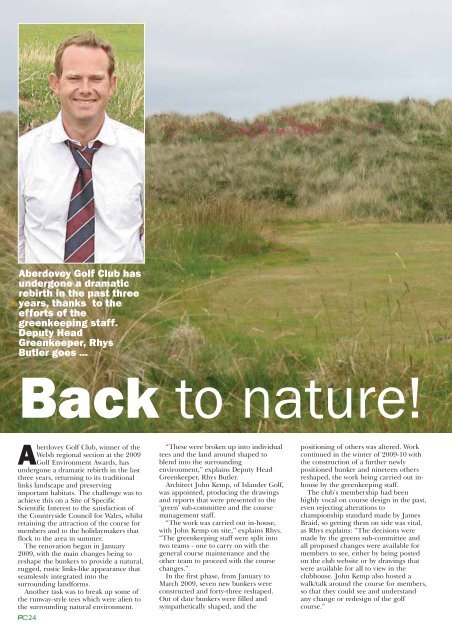Marshalling his troops - Pitchcare
Marshalling his troops - Pitchcare
Marshalling his troops - Pitchcare
You also want an ePaper? Increase the reach of your titles
YUMPU automatically turns print PDFs into web optimized ePapers that Google loves.
Aberdovey Golf Club has<br />
undergone a dramatic<br />
rebirth in the past three<br />
years, thanks to the<br />
efforts of the<br />
greenkeeping staff.<br />
Deputy Head<br />
Greenkeeper, Rhys<br />
Butler goes ...<br />
Back to nature!<br />
Aberdovey Golf Club, winner of the<br />
Welsh regional section at the 2009<br />
Golf Environment Awards, has<br />
undergone a dramatic rebirth in the last<br />
three years, returning to its traditional<br />
links landscape and preserving<br />
important habitats. The challenge was to<br />
achieve t<strong>his</strong> on a Site of Specific<br />
Scientific Interest to the satisfaction of<br />
the Countryside Council for Wales, whilst<br />
retaining the attraction of the course for<br />
members and to the holidaymakers that<br />
flock to the area in summer.<br />
The renovation began in January<br />
2009, with the main changes being to<br />
reshape the bunkers to provide a natural,<br />
rugged, rustic links-like appearance that<br />
seamlessly integrated into the<br />
surrounding landforms.<br />
Another task was to break up some of<br />
the runway-style tees which were alien to<br />
the surrounding natural environment.<br />
24<br />
“These were broken up into individual<br />
tees and the land around shaped to<br />
blend into the surrounding<br />
environment,” explains Deputy Head<br />
Greenkeeper, Rhys Butler.<br />
Architect John Kemp, of Islander Golf,<br />
was appointed, producing the drawings<br />
and reports that were presented to the<br />
‘green’ sub-committee and the course<br />
management staff.<br />
“The work was carried out in-house,<br />
with John Kemp on site,” explains Rhys.<br />
“The greenkeeping staff were split into<br />
two teams - one to carry on with the<br />
general course maintenance and the<br />
other team to proceed with the course<br />
changes.”<br />
In the first phase, from January to<br />
March 2009, seven new bunkers were<br />
constructed and forty-three reshaped.<br />
Out of date bunkers were filled and<br />
sympathetically shaped, and the<br />
positioning of others was altered. Work<br />
continued in the winter of 2009-10 with<br />
the construction of a further newly<br />
positioned bunker and nineteen others<br />
reshaped, the work being carried out inhouse<br />
by the greenkeeping staff.<br />
The club’s membership had been<br />
highly vocal on course design in the past,<br />
even rejecting alterations to<br />
championship standard made by James<br />
Braid, so getting them on side was vital,<br />
as Rhys explains: “The decisions were<br />
made by the greens sub-committee and<br />
all proposed changes were available for<br />
members to see, either by being posted<br />
on the club website or by drawings that<br />
were available for all to view in the<br />
clubhouse. John Kemp also hosted a<br />
walk/talk around the course for members,<br />
so that they could see and understand<br />
any change or redesign of the golf<br />
course.”


